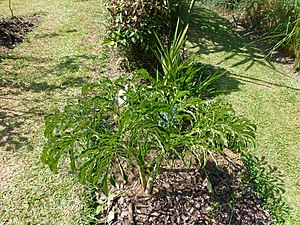Note: This is a project under development. The articles on this wiki are just being initiated and broadly incomplete. You can Help creating new pages.
Difference between revisions of "Amorphophallus campanulatus"
(→Chemical Composition) |
|||
| Line 65: | Line 65: | ||
==References== | ==References== | ||
<references> | <references> | ||
| − | <ref name="chemical composition">[ | + | <ref name="chemical composition">[https://www.researchgate.net/publication/263445567_Phytochemical_and_Nutritional_Evaluation_of_Amorphophallus_campanulatus_Roxb_Blume_Corm Chemistry]</ref> |
<ref name="Leaf">["morphology"]</ref> | <ref name="Leaf">["morphology"]</ref> | ||
<ref name="How to plant/cultivate">[http://tropical.theferns.info/viewtropical.php?id=Amorphophallus+paeoniifolius "Cultivation"]</ref> | <ref name="How to plant/cultivate">[http://tropical.theferns.info/viewtropical.php?id=Amorphophallus+paeoniifolius "Cultivation"]</ref> | ||
Revision as of 14:39, 20 March 2020
Contents
- 1 Uses
- 2 Parts Used
- 3 Chemical Composition
- 4 Common names
- 5 Properties
- 6 Habit
- 7 Identification
- 8 List of Ayurvedic medicine in which the herb is used
- 9 Where to get the saplings
- 10 Mode of Propagation
- 11 How to plant/cultivate
- 12 Commonly seen growing in areas
- 13 Photo Gallery
- 14 References
- 15 External Links
Uses
Piles, Dysentery, Acute rheumatism, Snakebites,Diarrhoea.
Parts Used
Chemical Composition
Standard β-sitosterol was procured from Sigma-Aldrich (Steinheim, Germany). Solvents used to prepare mobile phase solutions were of HPLC grade and purchased from Merck (Germany). [1]
Common names
| Language | Common name |
|---|---|
| Kannada | |
| Hindi | |
| Malayalam | |
| Tamil | |
| Telugu | |
| Marathi | |
| Gujarathi | |
| Punjabi | |
| Kashmiri | |
| Sanskrit | |
| English |
Properties
Reference: Dravya - Substance, Rasa - Taste, Guna - Qualities, Veerya - Potency, Vipaka - Post-digesion effect, Karma - Pharmacological activity, Prabhava - Therepeutics.
Dravya
Rasa
Guna
Veerya
Vipaka
Karma
Prabhava
Habit
Identification
Leaf
| Kind | Shape | Feature |
|---|---|---|
Flower
| Type | Size | Color and composition | Stamen | More information |
|---|---|---|---|---|
| {{{5}}} |
Fruit
| Type | Size | Mass | Appearance | Seeds | More information |
|---|---|---|---|---|---|
Other features
List of Ayurvedic medicine in which the herb is used
Where to get the saplings
Mode of Propagation
How to plant/cultivate
A temperature in the range of 25 - 35°c is required with an annual rainfall of 1,000 - 1,500mm.[3]
Commonly seen growing in areas
Secondary forests, Shrub forests, Grasslands.
Photo Gallery
References
- ↑ Chemistry
- ↑ ["morphology"]
- ↑ "Cultivation"
External Links
Categories:
- Pages that are stubs
- Ayurvedic Herbs known to be helpful to treat Piles
- Ayurvedic Herbs known to be helpful to treat Dysentery
- Ayurvedic Herbs known to be helpful to treat Acute rheumatism
- Ayurvedic Herbs known to be helpful to treat Snakebites
- Ayurvedic Herbs known to be helpful to treat Diarrhoea
- Herbs with Young leaves used in medicine
- Habit - Perennial
- Index of Plants which can be propagated by Seeds
- Herbs that are commonly seen in the region of Secondary forests
- Herbs that are commonly seen in the region of Shrub forests
- Herbs that are commonly seen in the region of Grasslands
- Herbs
- Pages without herbs images

